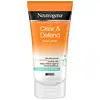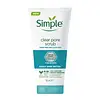What's inside
What's inside
 Key Ingredients
Key Ingredients

 Benefits
Benefits

 Concerns
Concerns

 Ingredients Side-by-side
Ingredients Side-by-side

Water
Skin ConditioningSodium C14-16 Olefin Sulfonate
CleansingCocamidopropyl Hydroxysultaine
CleansingSorbitol
HumectantCellulose
AbsorbentSalicylic Acid
MaskingSodium Hydrolyzed Potato Starch Dodecenylsuccinate
Acrylates Crosspolymer-4
Emulsion StabilisingC12-15 Alkyl Lactate
EmollientPanthenol
Skin ConditioningCocamidopropyl Pg-Dimonium Chloride Phosphate
Talc
AbrasiveDisodium Tetrapropenyl Succinate
Cera Microcristallina
Emulsion StabilisingSodium Chloride
MaskingDisodium EDTA
Citric Acid
BufferingSodium Hydroxide
BufferingBenzalkonium Chloride
AntimicrobialParfum
MaskingCI 19140
Cosmetic ColorantCI 73360
Cosmetic ColorantWater, Sodium C14-16 Olefin Sulfonate, Cocamidopropyl Hydroxysultaine, Sorbitol, Cellulose, Salicylic Acid, Sodium Hydrolyzed Potato Starch Dodecenylsuccinate, Acrylates Crosspolymer-4, C12-15 Alkyl Lactate, Panthenol, Cocamidopropyl Pg-Dimonium Chloride Phosphate, Talc, Disodium Tetrapropenyl Succinate, Cera Microcristallina, Sodium Chloride, Disodium EDTA, Citric Acid, Sodium Hydroxide, Benzalkonium Chloride, Parfum, CI 19140, CI 73360
Water
Skin ConditioningHamamelis Virginiana Leaf Water
AstringentCocamidopropyl Betaine
CleansingGlycerin
HumectantBambusa Arundinacea Stem Extract
Skin ConditioningSodium Laureth Sulfate
CleansingPEG-7 Glyceryl Cocoate
EmulsifyingAcrylates/C10-30 Alkyl Acrylate Crosspolymer
Emulsion StabilisingBenzophenone-4
UV AbsorberCitric Acid
BufferingHydroxypropyl Cyclodextrin
MaskingIodopropynyl Butylcarbamate
PreservativeNiacinamide
SmoothingPanthenol
Skin ConditioningPantolactone
HumectantPhenoxyethanol
PreservativePotassium Sorbate
PreservativeSodium Benzoate
MaskingSodium Chloride
MaskingSodium Hydroxide
BufferingThymus Vulgaris Flower/Leaf Extract
MaskingXanthan Gum
EmulsifyingZinc PCA
HumectantWater, Hamamelis Virginiana Leaf Water, Cocamidopropyl Betaine, Glycerin, Bambusa Arundinacea Stem Extract, Sodium Laureth Sulfate, PEG-7 Glyceryl Cocoate, Acrylates/C10-30 Alkyl Acrylate Crosspolymer, Benzophenone-4, Citric Acid, Hydroxypropyl Cyclodextrin, Iodopropynyl Butylcarbamate, Niacinamide, Panthenol, Pantolactone, Phenoxyethanol, Potassium Sorbate, Sodium Benzoate, Sodium Chloride, Sodium Hydroxide, Thymus Vulgaris Flower/Leaf Extract, Xanthan Gum, Zinc PCA
 Reviews
Reviews

Ingredients Explained
These ingredients are found in both products.
Ingredients higher up in an ingredient list are typically present in a larger amount.
Citric Acid is an alpha hydroxy acid (AHA) naturally found in citrus fruits like oranges, lemons, and limes.
Like other AHAs, citric acid can exfoliate skin by breaking down the bonds that hold dead skin cells together. This helps reveal smoother and brighter skin underneath.
However, this exfoliating effect only happens at high concentrations (20%) which can be hard to find in cosmetic products.
Due to this, citric acid is usually included in small amounts as a pH adjuster. This helps keep products slightly more acidic and compatible with skin's natural pH.
In skincare formulas, citric acid can:
While it can provide some skin benefits, research shows lactic acid and glycolic acid are generally more effective and less irritating exfoliants.
Most citric acid used in skincare today is made by fermenting sugars (usually from molasses). This synthetic version is identical to the natural citrus form but easier to stabilize and use in formulations.
Read more about some other popular AHA's here:
Learn more about Citric AcidPanthenol is a common ingredient that helps hydrate and soothe the skin. It is found naturally in our skin and hair.
There are two forms of panthenol: D and L.
D-panthenol is also known as dexpanthenol. Most cosmetics use dexpanthenol or a mixture of D and L-panthenol.
Panthenol is famous due to its ability to go deeper into the skin's layers. Using this ingredient has numerous pros (and no cons):
Like hyaluronic acid, panthenol is a humectant. Humectants are able to bind and hold large amounts of water to keep skin hydrated.
This ingredient works well for wound healing. It works by increasing tissue in the wound and helps close open wounds.
Once oxidized, panthenol converts to pantothenic acid. Panthothenic acid is found in all living cells.
This ingredient is also referred to as pro-vitamin B5.
Learn more about PanthenolChances are, you eat sodium chloride every day. Sodium Chloride is also known as table salt.
This ingredient has many purposes in skincare: thickener, emulsifier, and exfoliator.
You'll most likely find this ingredient in cleansers where it is used to create a gel-like texture. As an emulsifier, it also prevents ingredients from separating.
There is much debate on whether this ingredient is comedogenic. The short answer - comedogenic ratings don't tell the whole story. Learn more about comegodenic ratings here.
The concensus about this ingredient causing acne seems to be divided. Research is needed to understand if this ingredient does cause acne.
Scrubs may use salt as the primary exfoliating ingredient.
Learn more about Sodium ChlorideSodium Hydroxide is also known as lye or caustic soda. It is used to adjust the pH of products; many ingredients require a specific pH to be effective.
In small amounts, sodium hydroxide is considered safe to use. However, large amounts may cause chemical burns due to its high alkaline.
Your skin has a natural pH and acid mantle. This acid mantle helps prevent harmful bacteria from breaking through. The acid mantle also helps keep your skin hydrated.
"Alkaline" refers to a high pH level. A low pH level would be considered acidic.
Learn more about Sodium HydroxideWater. It's the most common cosmetic ingredient of all. You'll usually see it at the top of ingredient lists, meaning that it makes up the largest part of the product.
So why is it so popular? Water most often acts as a solvent - this means that it helps dissolve other ingredients into the formulation.
You'll also recognize water as that liquid we all need to stay alive. If you see this, drink a glass of water. Stay hydrated!
Learn more about Water